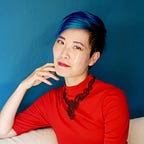On gender and racial equity in the coffee industry
Intersectionality is a word I learned only recently. It puts a label on what I feel a little too often when I’m out and about in the world.
I’ve played with the topic of this post for almost a year now. Every time, I struggle with what is too much to share and how much possible harassment I’m willing to deal with.
In Chicago, I would routinely receive gendered street harassment. Five times daily seems like a conservative estimate, especially when using public transit. Racial street harassment was about once a week. San Francisco isn’t without this, either. Earlier this week, someone smiled at me and “complimented” me with “You look like a China doll.”
Sometimes, I don’t know whether it’s my race or my gender that people take affront at.
Being conscious of my race has followed me around for my whole life. Being conscious of my gender has only struck me more in the last half decade.
This consciousness was a slow buildup of many minuscule moments. What is the saying? Death by a thousand cuts.
I’m fortunate to work in a welcoming industry. However, there is much progress to be made about gender equity in coffee and let me be clear here: I am writing this from my own experiences.
I tell people that I stopped being a barista, because I don’t like people. This is partially true. I don’t like in-person customer service. When you’re a barista, you’re in the power dynamic of the customer always being right. When a customer started questioning my ethnicity (e.g. Where are you from? No. Where are you really from?), I couldn’t be a bitch and call them out on being racist. The cafe’s owner was there, but laughed it off.
Let me list some other minuscule moments:
- When working a trade show booth: being ignored. I was sometimes the only woman and people would wait to ask their question to my male colleagues. Maybe it was cultural. Maybe it was gendered. Some people would come up to me and start speaking in Mandarin or Japanese OR assume that I could only speak those languages.
- When I took to Twitter to talk about the above feelings, I also spoke about feeling a lack of women in coffee to look up to. Instead of being listened to, someone oh-so-helpfully pointed me to some amazing women in the industry. That is classic ‘splaining. And then they proceeded to tell me that the change for equality was going to be multi-generational. THANKS.
- Walking into many latte art throwdowns and seeing it be 80% dudes.
- Going to conferences and seeing all-white, cis-gender male panels.
- Seeing butt cleavage on a national coffee competition poster and having the global organizer actually ask on social media what they should do.
- Seeing a multitude of event posters feature men competing. Here. Here. Here.
- Talking about gender equity and hearing lamentations of “When are we going to stop talking about gender?”
- At Barista Camp, hearing a loved industry pro tell a really crass joke about a woman’s vagina and sex life. Everyone laughed.
- Someone told me that my people were going to take over the World Latte Art Championship, didn’t you see the Oriental person who won?
- Seeing photos of booth babes and beer babes on an industry company’s social pages at an industry-sanctioned event.
- Do I even need to mention the multitude of men who have won so many national and international competitions?
- Someone asked in a business email if I was related to their friend in China with a last name of Chen — and if I was from China. Do you know how popular that last name is? It’s the 5th most common surname in China. Then they got offended that I got offended.
So what can the industry do better?
Have you read Coffee Quality Institute’s Gender Equity report? It’s filled with a truckload of recommendations. Among some:
- Put women in leadership positions.
- Proclaim gender equity as a company value. Make a concerted effort to uncover unconscious bias and promote equally.
Here are some other ideas:
- Create a Code of Conduct for trade events. To quote that source I just linked:
A Code of Conduct is a public statement that sets the ground rules for participating in an event. Our conferences boast attendees from all over the world, coming from many different backgrounds and experiences; our expectations of what is appropriate are not always in line with one another. A policy like this ensures that everyone is on the same page without any gray areas and even better, that there will be less rules-lawyering.
- For panels or competitions, make sure there’s equal representation of genders
- Offer mentorship and make it easy to pair up mentors and mentees.
Learning from the tech industry
The tech industry has been talking about gender and racial equity for a while now and I’m seeing repeats of the same mistakes. Maybe the coffee industry’s issues are not as widespread as the tech industry’s is.
Read up on how technical conferences have been working through this issue.
If you feel uncomfortable or afraid to tell your story, message me and I will be happy to tell yours anonymously.
Full disclosure: CQI is currently a client. That aside, the work they are doing to further gender equity along the coffee value chain is a HUGE deal. The report is well worth the read.
Edited on 04.01.16 to add link to intersectionality illustration, the second part of the China doll conversation & the message on how to contact me if you’d like to discuss your experiences privately.
Edited on 07.17.16: I’ve received a lot of responses to this piece & I wrote a follow-up piece, linked below.
